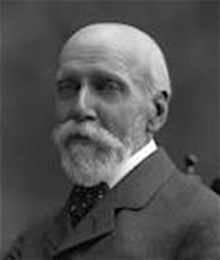
Ernest George [also known as Sir Ernest George] was born in Southwark, Surrey [now London], England on 13 June 1839 and was articled to Samuel Hewitt (?-1877) in London. From 31 March 1857 he attended the Royal Academy Schools in London where he was awarded the Gold Medal in 1859.
After a period travelling abroad, he returned to London and in c.1861 formed a partnership with Thomas Vaughan (1836?-1875) who had been a fellow student at the Royal Academy.
Vaughan died in 1875, and the following year George formed a new partnership with Harold Ainsworth Peto (1854-1933), Ernest George & Peto
Ill health forced Peto to retire from the practice in 1892 and later that year George formed his final partnership, Ernest George & Yeates, with Alfred Bowman Yeates (1867-1944) in London. The partnership between George and Yeates was dissolved in 1919.
In addition to his work as an architect, George was also a painter and etcher. He exhibited at Dudley Gallery, Fine Art Society, Royal Academy, Royal Society of British Artists, Royal Society of Painter-Etchers and Engravers, and Royal Institute of Painters in Water Colours in London; the Royal Hibernian Academy in Dublin; and at the Royal Scottish Academy in Edinburgh. A watercolour by him entitled 'Messina in 1904' is illustrated in Architectural Review February 1910 p.66
George was elected an Associate of the Royal Society of British Architects (A.R.I.B.A.) in 1861 and Fellow of the Royal Institute of British Architects (F.R.I.B.A.) in 1881. He was a member of the Royal Society of Painter-Etchers and Engravers (R.E.) in 1881; a member of the Royal British Academy (R.B.A.) in 1889; an Associate of the Royal Academy (A.R.A.) in 1910; and a Royal Academician (R.A.) in 1917. In 1896 he was awarded the Royal Gold Medal by the Royal Institute of British Architecture and was knighted for his services to architecture in 1912.
George died at his home in in Bayswater, London on 8 December 1922. His funeral took place on 18 December 1922 at Golders Green crematorium, which he had designed in 1901.
With Thomas Vaugan: a country house for Sir Henry Peek in Rousdon, Devon, a church in St. Pancras, London, and various farm buildings and schools.
With Harold Ainsworth Peto: premises for Thomas Goode & Co. in South Audley Street, London (1875–76); Ossington Coffee Palace in Newark-on-Trent, Nottinghamshire (1881–82); and serveral country houses including Buchan Hill, Crawley, Sussex (1882–84); Batsford Park, Gloucestershire (1887–88), Shiplake Court, Oxfordshire (1889–91); Poles, Ware, Hertfordshire (1890–92); Limnerslease, Compton, Surrey, for G.F. Watts (1891); West Dean Park, Sussex (1891–93); Motcombe House, Shaftesbury, Dorset (1892–94); additions and garden, North Mymms, Hertfordshire (1892–98);
With Alfred Bowman Yeates: West Dean Park near Chichester, Sussex, 1891- 93 and 1905; Colworth, Sharnbrook, Bedfordshire, 1894-95; Shockerwick House, Bathford, Somerset, 1896 and 1906-07; Cawston Manor, Cawston, Norfolk, 1896; Billiard, Smoking and Dining Rooms, Claridges Hotel, London, 1897; Okewood, Horsham, Sussex, 1898; Edgeworth Manor, Cirencester, Gloucestershire, 1898-1900; Foxcombe, Boars Hill, Oxfordshire, c.1898-c.1904; houses for Port Sunlight, Cheshire, 1899-1901; Holwell, Hatfield, Hertfordshire, 1900; Woodside, Esher, Surrey, 1912; alterations to Welbeck Abbey, near Worksop, Nottinghamshire, 1900-02; Wayford Manor, Crewkerne, Somerset, C. 1902; Crathorne Hall, Yarm-on-Tees, Yorkshire, 1903-06; the British Pavilion, St. Louis Exhibition 1904; cottages in Eaton Hastings, Berkshire, 1904; Olveston, Dunedin, New Zealand, 1904-06; Eynsham Hall, Witney, Oxfordshire, 1904-08; hunting stables, Foston Hall, Derby, Derbyshire, 1905; Greycroft, Newbury, Berkshire, 1905; Busbridge Hall, Godalming, Surrey, 1906; The Royal Exchange Buildings, 1-4 Cornhill, London, 1906-10; a Public School for Girls, Athens, Greece, 1908; Putteridge Bury, Lilley, Hertfordshire, 1908-11; Encombe, Sandgate, Folkestone, Kent, 1909; Royal Academy of Music, Marylebone Road, London, 1910-11; Golders Green Crematorium, London, 1910-11; premises for Messrs Grafton, 17 Grafton Street, London, 1910-11; cottages in Whiteley Village, Surrey, 1911; a Lumber House, British Guiana [now Guyana], 1912; Shirpur Palace, Indore, Madhya Pradesh, India, 1914-15; St Chads Wood, Kidderminster, Worcestershire, 1918; a bungalow for Nairobi, British East Africa [now Kenya], 1919; and War Memorial, Berriedale, Caithness, Scotland, 1919. The partnership between George and Yeates was dissolved in 1919.
_____
See also:
Historic England - Ernest George & Peto
British Listed Buildings - Ernest George & Peto
Historic England - Ernest George & Yeates
British Listed Buildings - Ernest George & Yeates
Armstrong, Barrie and Armstrong, Wendy. The Arts and Crafts movement in the North West of England: a handbook. Wetherby, England: Oblong Creative Ltd., 2006
Bradell, Darcy. 'Architectural reminiscences . . . 'Fugaces Anni''. The Builder vol. 168, 12 January 1945 pp. 27-29 [Bradell reminiscences about his experience as a pupil of Ernest George]
Directory of British Architects 1834-1914. Compiled by Antonia Brodie, et al. Volume 1: A-K. London; New York: British Architectural Library, Royal Institute of British Architects/Continuum, 2001
George, Ernest. ‘An architect reminiscence’. The Builder vol.120, 1921 pp.622-633
Girouard, Mark. The Victorian Country House. New Haven and London: Yale University Press, revised and enlarged edition, 1979
Grainger, Hilary Joyce. The Architecture of Sir Ernest George. Reading : Spire, 2011.
Grainger, Hilary Joyce. The Architecture of Sir Ernest George and his Partners, c.1860-1922, 4 volumes. Ph.D. thesis, University of Leeds, 1985
Gray, A. Stuart. Edwardian Architecture: a Biographical Dictionary. London: Gerald Duckworth & Co., Ltd., 1985
Hellyer, Arthur. ‘Trim and wild together: gardens of Wayford Manor, near Crewkerne, Somerset; architect of 1899 north wing : Sir Ernest George, designer of the gardens, his partner, : Harold Peto’. Country Life vol. 177, no. 4568, 7 March 1985 pp. 560-563
‘Obituary’. Architects’ Journal vol. 56, 20 December 1922 p. 855, 857-60
‘Obituary’. The Builder vol. 123, 15 December 1922 pp. 900-903
‘Obituary’. RIBA Journal vol. 30, 1923 pp. 106-107
Stamp, Gavin. ‘Architecture: Ernest George’. Apollo vol. 174, no. 589, July/August 2011 pp. 72-73.
Who's Who in Architecture 1914. London: Technical Journals Ltd., 1914